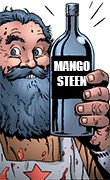|
ryonguy posted:Film of the last day the New York Times was done on linotype, with interviews of several of the workers at the time. Wow... I never knew that was how it was done.
|
|
|
|

|
| # ? May 30, 2024 10:25 |
|
That video made me sad, looking at all those middle aged guys too old to start a new career and too young to retire who had a good blue-collar job until that day, after which they're probably delivering pizza or something, or killing themselves, literally or implicitly with booze. What do you do when you've spent the best years of your life becoming a master of something no one needs anymore?
|
|
|
|
LifeSunDeath posted:Oh poo poo, weren't these like 10k back in the day? That is, if you were paying list for everything. Which virtually nobody did. If you're in the market for a graphics workstation that costs as much as a car you're probably in the market for several of them, so everybody pretty much either had a relationship with their local SGI sales rep or did business through somebody who did. Back when I was considering buying an Indy in the mid '90s I was at a research institution at a university, and faculty and staff could buy SGI hardware through the institute at a discount. I don't remember all the details, but I remember that at the time an Indy was like US$5k but with the discount it would've been just over US$3k. But I ended up getting a third-party 21164 alpha for around US$4k because it had blazing fast floating point performance compared to anything else made at the time.
|
|
|
|
stevewm posted:Wow... I never knew that was how it was done. same.... it's such an overwhelming pain in the rear end, and they did it that way for a century. Incredible.
|
|
|
|
Imagined posted:That video made me sad, looking at all those middle aged guys too old to start a new career and too young to retire who had a good blue-collar job until that day, after which they're probably delivering pizza or something, or killing themselves, literally or implicitly with booze. What do you do when you've spent the best years of your life becoming a master of something no one needs anymore? I know it was one guy's last day, but I thought at the end a bunch of them were typing into terminals? e: Also thanks ryonguy, that was great, and it was only when watching it that I realized linotype probably stands for "line o' type" (Wikipedia confirms this). Previously I assumed the process somehow involved linoleum Buttcoin purse has a new favorite as of 06:11 on Jan 25, 2020 |
|
|
|
ryonguy posted:Film of the last day the New York Times was done on linotype, with interviews of several of the workers at the time. As a former newspaper paginator, this is fascinating. Now, I've done a bit of paste-up, back when there was still a printer on this side of Texas who could process those. Mostly as an exercise, I got into the newspaper business long after DTP was standard. I still prefer digital pagination - mostly because I can do twelve pages per hour in Indesign vs. two per hour paste-up, and I don't have to spend time printing photos and sizing them - but there was something zen about paste-up. A very calming exercise, right up until deadlines loomed.
|
|
|
|
I guess there was no way to be able to do a whole page in a computer at that time? Crazy that they went from perfectly lined up metal printing plates to some guy gluing a cutout piece of paper. It's insane to me that they were doing all that lead casting to make the newspaper. Was there no other metal they could have used like tin or something?
|
|
|
|
Printer's lead was used because of it's combination of durability - you saw those guys banging around and otherwise handling the printing surface - and a melting point in the lower hundreds of degrees instead of upper hundreds/lower thousands. e. Specifically, Linotype Alloy, 4% Tin, 12% Antimony, and 84% Lead And no, entire pages at a time wasn't a thing until Aldus Pagemaker came out in '85, and it was honestly faster to do paste-up until the mid-90's or so, after computers got a lot more powerful. The little weekly I worked at didn't switch to fully DTP until the original Creative Suite came out in '03. When it went out of business I took the pagination table and various sundries and built a little paste-up display we donated to the local museum, along with our entire bound archive. rndmnmbr has a new favorite as of 07:50 on Jan 25, 2020 |
|
|
|
Imagined posted:That video made me sad, looking at all those middle aged guys too old to start a new career and too young to retire who had a good blue-collar job until that day, after which they're probably delivering pizza or something, or killing themselves, literally or implicitly with booze. What do you do when you've spent the best years of your life becoming a master of something no one needs anymore? The Times was probably way ahead of the curve. No doubt that these guys could have moved to other press facilities and hung on years more. rndmnmbr posted:And no, entire pages at a time wasn't a thing until Aldus Pagemaker came out in '85, and it was honestly faster to do paste-up until the mid-90's or so, after computers got a lot more powerful. The little weekly I worked at didn't switch to fully DTP until the original Creative Suite came out in '03. When it went out of business I took the pagination table and various sundries and built a little paste-up display we donated to the local museum, along with our entire bound archive. Curious. Was there any way to do double trucks on those? I know it wouldn't have been more convenient, but would have it been possible to do them? (For those unfamiliar: double trucks.) RC and Moon Pie has a new favorite as of 08:02 on Jan 25, 2020 |
|
|
|
rndmnmbr posted:And no, entire pages at a time wasn't a thing until Aldus Pagemaker came out in '85, and it was honestly faster to do paste-up until the mid-90's or so, after computers got a lot more powerful. The little weekly I worked at didn't switch to fully DTP until the original Creative Suite came out in '03. When it went out of business I took the pagination table and various sundries and built a little paste-up display we donated to the local museum, along with our entire bound archive. And all the graphical poo poo, not counting photography, was done with clip art (out of a stack of physical books of clip art), end tape (literal sticky tape that had various solid line, dotted line, dashed line, and so on patterns on it) and Ben Day (dry rub transfer things that had various black and white fill patterns on them, like cross hatching and so on--cut out the appropriate shape and rub it to get it to stick).
|
|
|
|
I had a stack of CD-ROMs full of clipart, but another paper in our little company still had the books of clipart dating back to the 70's. I wanted to digitize all of it, but never had the chance. Also rolls and rolls of end tape, and an unused but fully equipped darkroom - just needed chemicals and fresh photo paper to start it right back up. Plus marks on the floor where a linotype and a press once sat. I'm a little sad to say I personally trashed most of the paste-up setup at our paper, but the office we moved to was tiny and we didn't have room. It - along with a tech hoarder's wet dream of late 90's/early 00's obsolete tech I've mentioned above in the thread - went straight in the dumpster. RC and Moon Pie posted:Curious. Was there any way to do double trucks on those? I know it wouldn't have been more convenient, but would have it been possible to do them? I honestly don't know, software wise, but I can already think of a couple ways to pull it off. But I know our printer didn't support it. The Lubbock Avalanche-Journal did it on occasion, but they only did a tiny handful of outside work. e. Call your printer, say "We're doing double-truck pages, got a QXP/ID template for me to use?" and prepare to be disappointed. 
rndmnmbr has a new favorite as of 11:29 on Jan 25, 2020 |
|
|
|
Stoatbringer posted:Ooh, did the Alpha have one of those awesome round mice with two angled wheels instead of a mouse ball? They were the tits. In my first job I had a Honeywell mouse like that. It was indeed excellent. So easy to get accurate tiny movements in the direction you wanted. SubG posted:You'll notice that I've described how to remove the CPU board, the graphics board, and the drives and none of this involved using any tools. The Mac IIsi was like that, too!
|
|
|
|
ryonguy posted:Film of the last day the New York Times was done on linotype, with interviews of several of the workers at the time. This loving rules. My dad was a pressman his entire life, not at newspapers, but doing business cards / letterheads and all kinds of specialty order work. He seemed to have every big company in Portland (OR) as his client. It fascinated me watching him set the type in the frames that he'd load into his gigantic deathtrap press, a Heidelberg:  I'm fairly sure it was this exact model. I remember that big nameplate at the top, and the center part is a two armed windmill with what always looked to me like a cyclopean robot's head in the middle:  Typesetting involved a big, heavy metal frame, the type to be set, wooden blocks to align it correctly in the frame, and these metal bars which could be expanded using a tool to tighten it all up. He'd set it all up, tighten up the metal bars, verify the text / logo was in the right place, loosen the bars, adjust the wood, and repeat until it was perfect.  I call it a deathtrap because I remember him telling me the safety feature linked to that nameplate wasn't functional. If I recall, the nameplate rotates upwards clockwise, to allow better access to the press for loading the frame, but it also is supposed to turn the press off if it's running, which his apparently did not. He somehow retired with all of his limbs.  He also complained about nerve damage to his knee, from operating that red knob with his knee (which iirc is a lever that controls... something, I think I remember it needing to be pulled out and locked in place for some reason, and I imagine he hit it with his knee to disengage?) He also complained about nerve damage to his knee, from operating that red knob with his knee (which iirc is a lever that controls... something, I think I remember it needing to be pulled out and locked in place for some reason, and I imagine he hit it with his knee to disengage?)Watching the machine run, and watching him operating it, was fascinating. The center piece which held the two windmill arms would lower down, and one of the arms would pick up the blank paper from the stack on the left (image left). The center would then lift back into the press, the paper would get pressed against the type, and then the center piece would lower down and rotate the arm to the right, dropping the paper in the other tray. All the while, the ink rollers (the shiny things at the center top of the image) would roll down and re-ink the frame in between pressings. I remember he'd occasionally have to go behind it and re-ink the rollers using a paint scraper (it was REALLY thick ink). I think the lever on the left of the image, along the side of it, was the main on/off for the press, and the dials and levers along the bottom front were for fine tuning or possibly adjusting the type frame. I remember when he'd first start a job, he'd be adjusting dials and throwing levers around and testing to make sure everything was aligned correctly. Watching it run was like this beautiful clockwork process of wheels and gears and movements in perfect sync. God just looking at photos of that press takes me back to hanging out in his shop, the smell of the solvents (I have a weird love of the smell of industrial solvents because of this), the sound of the presses (mainly the vacuum wooshing sounds from the device that lifted the paper into the windmill arm), browsing through the dozens and dozens of really old cabinets packed full of linotype text / company logos... He also had another press for doing foil work, but I don't recall what it was. I don't know if I ever saw him use that, but I saw work he'd finished with it, and it looked amazing. I remember in particular he'd made envelopes with this really cool green foil mountain range design on them. I wish I still had those cool-rear end envelopes... I still miss the look and feel of the business cards and other things he created. Yeah, yeah, maybe I identified with Patrick Bateman gushing over the quality of the business cards in American Psycho, so what?  It's blowing my mind that I'm able to find absolutely perfect photos of what he worked with. None of those are my photos, but... yeah, that's exactly it. Same exact press, and the frames look about right (and I swear he had literally that same exact T-shaped tool for tightening them). I haven't really looked at this stuff in 20+ years, and it's blowing my mind to see it again.
|
|
|
|
Something else our sister paper had was God's own guillotine. Motorized, could slice through a couple reams of paper/cardstock without blinking, no safety features. I always had the owners do our renewal notices over there on that badass machine.
|
|
|
|
Imagined posted:That video made me sad, looking at all those middle aged guys too old to start a new career and too young to retire who had a good blue-collar job until that day, after which they're probably delivering pizza or something, or killing themselves, literally or implicitly with booze. What do you do when you've spent the best years of your life becoming a master of something no one needs anymore? Obsolete technology: They had a solid union. None of them are freaking out because they know they will get paid to retrain, or moved to another paper that still uses linotype.
|
|
|
|
Cojawfee posted:I guess there was no way to be able to do a whole page in a computer at that time? Crazy that they went from perfectly lined up metal printing plates to some guy gluing a cutout piece of paper. It's insane to me that they were doing all that lead casting to make the newspaper. Was there no other metal they could have used like tin or something? I think one of the problems you’d run into with tin is that it’s too brittle. Hammering away at a page hundreds of times per minute would not work well with tin.
|
|
|
|
Lead is really good stuff. It's just a shame about the whole "degrades anything biological" thing.
|
|
|
|
bring back old gbs posted:same.... it's such an overwhelming pain in the rear end, and they did it that way for a century. Incredible. Gotta be faster than any other way if they did it for a hundred years.
|
|
|
|
When I was growing up, my brother's friends' father had a hobby Linotype machine. An entire linotype machine in his barn. It was so cool. He did each of our names for us, and I remember how hot the leads were as they dropped into the tray. Those suckers are mechanical magic.
|
|
|
|
Now, I have a question: why this entire machine, that was the default for mass printing for a century, that is insanely complex and expensive, using hot molten metal to rapid-form letter blocks instead of a simpler system that just drops reusable steel letter blocks into position? Is it entirely about making sure the lines are justified, or was there something more?
ryonguy has a new favorite as of 18:29 on Jan 25, 2020 |
|
|
|
I think it is so they can easily move lines around without having to worry about individual letters being messed up
|
|
|
|
ryonguy posted:Now, I have a question: why this entire machine, that was the default for mass printing for a century, that is insanely complex and expensive, using hot molten metal to rapid-form letter blocks instead of a simpler system that just drops reusable steel letter blocks into position?
|
|
|
|
ryonguy posted:Now, I have a question: why this entire machine, that was the default for mass printing for a century, that is insanely complex and expensive, using hot molten metal to rapid-form letter blocks instead of a simpler system that just drops reusable steel letter blocks into position? Is it entirely about making sure the lines are justified, or was there something more? they had that one guy who machined/grinded the entire paragraph blocks down so they'd perfectly slide into the clamping brackets. Doing the letters individually would probably speed up the initial type setting and then get slowed down over time as you needed to custom grind/machine the individual letters so they don't get misaligned, thats my guess
|
|
|
|
ryonguy posted:Now, I have a question: why this entire machine, that was the default for mass printing for a century, that is insanely complex and expensive, using hot molten metal to rapid-form letter blocks instead of a simpler system that just drops reusable steel letter blocks into position? Is it entirely about making sure the lines are justified, or was there something more? I just measured a newspaper clipping I had handy. A single character (including the bit of space around the character) will be something on the order of 3 millimeters high, and anywhere from 1 to 2 millimeters wide depending on the letter. Somehow I don't see wrangling hundreds of thousands (millions?) of these teeny-tiny blocks as being any easier than the line-by-line casting method. And besides, it looked to me like what you were describing is what was happening inside the linotype machine itself: reusable letter blocks were lined up to form the mold. But because they were only doing one line at a time, the blocks only had to be narrow -- they could be as tall or as deep as you like for ease of handling. Think handling coins instead of needles. (One thing I was wondering about was how those blocks got sorted back out for reuse. Did the machine keep a memory of which one went where, or were they shaped on the back to allow automatic sorting, or were there hordes of interns and apprentices doing it by hand, or what?)
|
|
|
|
I assume there was some sort of mechanical keying that told the machine where to sort them.
|
|
|
|
Another advantage of the Linotype machine is that it would automatically adjust the spacing between words to make the text justified. That would be a huge pain to do by hand.
Mr.Radar has a new favorite as of 21:24 on Jan 25, 2020 |
|
|
|
It is clearly so boomers had even better ways to get lead into their brains.
|
|
|
|
Johnny Aztec posted:Lead is really good stuff. It's just a shame about the whole "degrades anything biological" thing. Same with Asbestos. Really awesome stuff with a ton of useful applications and sadly it kills you dead in a horrific way...
|
|
|
|
I worked at a trophy company for a few years and they had in the back, gathering dust, an ancient engraving machine. They only used it when they had to engrave something that was too delicate to use the auto engraver on. I think in my time there I saw it used twice, both for gold fountain pens.
|
|
|
|
Code Jockey posted:God just looking at photos of that press takes me back to hanging out in his shop, the smell of the solvents (I have a weird love of the smell of industrial solvents because of this) My father was an x-ray technician, so the smell of the fixer they used in processing the films always brought back memories of when I would have to hang out at the hospital. With everything having gone digital it's a bit weird to go for an x-ray without that smell being present.
|
|
|
|
Cojawfee posted:I assume there was some sort of mechanical keying that told the machine where to sort them. There is. Once a line is cast the metal letter tiles are returned to the top of the machine and sorted into chutes ready to be reused. The complete working of the machine is shown in this (blurry) video: https://www.youtube.com/watch?v=EzilaRwoMus
|
|
|
|
There's a really good history of printing tech in the latter half the book The Book by Kyle Houston. The linotype was the solution after over a century of attempts to speed up type setting.
|
|
|
|
|
Giant Metal Robot posted:There's a really good history of printing tech in the latter half the book The Book by Kyle Houston. The linotype was the solution after over a century of attempts to speed up type setting. Correction for anyone else searching: the author is Keith Houston. The irony of Audible being the first place I checked is not lost on me.
|
|
|
|
ryonguy posted:Film of the last day the New York Times was done on linotype, with interviews of several of the workers at the time. I sent this to my newspaper-photographer-of-50-years father and said "Bet you're glad they didn't trust anyone you worked with with molten lead." His reply was "actually the first two years we did. That was one of my first jobs, melting everything back into ingots." Imagined posted:What do you do when you've spent the best years of your life becoming a master of something no one needs anymore? Listen to a lot of AM radio and vote Republican.
|
|
|
|
Rev. Bleech_ posted:
the crazy far-right stuff is on FM where I live now radio has a lot of staying power, huh? There were a couple games during the 2015 world series I wanted to enjoy at home, since I'd gone out a few times in a row for the first three, but I have no cable or sports streaming subscription or w/e so I just fired up the MLB Game Day display in browser and dusted off a hand-crank emergency radio to listen to the AM feed it was wild to me that there was no FM station simulcasting the biggest game in our region in some time but I'm guessing that's the business end wanting people to pay for a high-quality stream still, even with the obnoxious aspects of AM (ope, some clouds somewhere moved, gotta reorient the radio), the crackle of the signal made for a really cozy baseball game experience
|
|
|
|
Peanut Butler posted:still, even with the obnoxious aspects of AM (ope, some clouds somewhere moved, gotta reorient the radio), the crackle of the signal made for a really cozy baseball game experience Kind of regret I never got the chance to take him to a game, now that I think about it. Anyway, the Dodgers in particular famously gated their games to, like, Time Warner a few years back so it wouldn't surprise me that cost and length of broadcast keep that poo poo out of FM -- what station's going to cut 3-4 hours of their JackFM playlist to broadcast stickball. VvV Oh yeah, it's still a cheap way for people to raise awareness about whatever act is being pushed now. Hell, I listen to old radio broadcasts from the 40s thanks to Sirius XM's RadioClassics channel and I loving love that poo poo. FilthyImp has a new favorite as of 18:58 on Jan 26, 2020 |
|
|
|
I think the concept of "radio" will stick around probably forever, just the technology will change. People still listen to a lot of radio or radio-like things like podcasts casually throughout the day, whether it's at their desk or in the car on the way to and from work.
|
|
|
|
|
Hello Thread, I present to you, a new in box Blazing fast 28.8 Macintosh External Modem  With bonus AoL Floppy DISK , also a Compuserve disk on the other side. Edit: Oh, also have a gallery of a SGI "Octane" system https://imgur.com/a/JEuqLc4 Similar to the "Indigo" posted earlier. I like how everything just slots in and out. Johnny Aztec has a new favorite as of 19:11 on Jan 26, 2020 |
|
|
|
There's also something to be said for letting an outsider curate a block of music, both because I don't always want to do that myself and for the off chance of hearing something new (or at least something I wouldn't have thought of unprompted).
|
|
|
|

|
| # ? May 30, 2024 10:25 |
|
Love this, it's definitely said in the most smug voice possible:
|
|
|



































